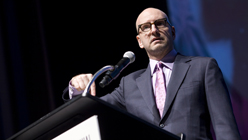Admittedly, Soderbergh has also directed mainstream hits like Erin Brockovich and Ocean’s Eleven and its sequels. But he also made the two-part, Spanish-language epic Che, which could hardly be called a commercial venture. Most recently, he revealed his decision to step away from movies and pursue painting. Perhaps it’s a strategy to slow the hum and regain the beat, but he made no reference and offered no explanation in his prepared remarks (and did not remain onstage to field questions afterward, as is customary).
At the Kabuki, Soderbergh noted that the casino set of Ocean’s Thirteen used a staggering $60,000 of electricity every week, and that getting him to San Francisco for this event made a carbon footprint. He feinted toward offering justifications for art, then pivoted in a more interesting direction. “Art is simply inevitable,” he declared. “It was on the wall of the cave in France thousands of years ago.” The fundamental impulse? “We are a species driven by narrative. We need to make sense out of all this chaos.”
At a time when our society is having obvious difficulties dealing with a number of challenges, Soderbergh noted, “Art is also about problem solving. In moviemaking, all ideas are on the table. Everyone submits to what the thing needs to be.” He gradually led into what proved to be, for this listener, his most relevant and valuable passage. “A movie is something you see,” he said. “Cinema is something that’s made, a specificity of vision, an approach in which everything matters.”
Soderbergh quickly tempered his tribute to film’s higher calling. “A piece of cinema may not qualify as a movie,” he noted. “It may be an unwatchable piece of s–t.” He left no doubt, however, that it is still very much worth aspiring to. Unfortunately, Soderbergh informed the crowd, “Cinema is under assault, by the studios and with the full support of the audience.”
The studios, owned by multinational corporations, employ few executives who love movies and know movies, Soderbergh informed us. He proceeded from this point on to identify and decry the risk-averse process of green-lighting, producing, testing and marketing Hollywood product. Never less than entertaining, he peppered his litany of frustration with offhand one-liners. “I could tell you a really great story of how I got pushed off a movie, but I’d probably get shot in the street,” he remarked. “And I really like my cats.”
While never less than amusing, this substantial chunk of Soderbergh’s talk offered nothing new to anyone who has spent five minutes reading about Hollywood in the last 20 years or simply observing the kind of movies the studios make (and, more importantly, don’t make). He didn’t argue for an overhaul of the studio system — Soderbergh is a pragmatist, not an anarchist, even if some of his ideas seem threateningly radical to execs — but merely a space where a small amount of “cinema” could be made alongside the mass of megabuck movies. He reported that the number of films released by the studios decreased 28 percent from 2003 to 2012 while the number of indie films doubled, yet the studios’ market share increased from 69 to 76 percent. “This is the force that is pushing cinema out of mainstream movies,” Soderbergh concluded.
It’s hardly surprising that a director would argue that the solution lay in his fellow artists. “In the film business, which is totally talent-driven, it’s about horses, not races,” he declared. He name-checked Shane Carruth (Upstream Color, currently at the Roxie), Barry Jenkins (Medicine For Melancholy, who was in the audience) and Amy Seimetz (Sun Don’t Shine) as “real talent, the kind that sustains. You can’t be judging on the basis of commercial success, or hype, or hipness.”
An interesting insight, to be sure, but hardly earthshaking. For all the juicy inside-baseball pleasure of Soderbergh’s talk, it was a missed opportunity. I wanted to hear him say who he looks to for pioneering approaches to storytelling. Does he envision Europe continuing to be a bastion of cinema, abetted by certain Asian filmmakers, or will every firewall be destroyed by Hollywood exports? (He was speaking at an international film festival, after all, not an industry conference.) In what ways can technology be a boon to film as art?



